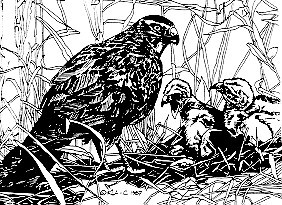

Description
The northern harrier, formerly known as the marsh hawk, hunts primarily on the wing and may cover up to 100 miles per day. Its prey, consisting of mostly rodents and small birds, is detected using extremely keen hearing. This 16-24 inch (41- 61 cm), slender-bodied hawk has a long tail and wings, long yellow legs, distinct facial disks and a conspicuous white rump patch. In flight, the wings are held in a shallow "V." The adult male is pale gray on the head, back and wings. The gray tail is banded with 6-8 gray-brown bars. There is cinnamon-brown spotting on the legs and flanks, and the wing linings and undertail are white. The eyes of an adult male are yellow. Female plumage is browner overall with dark streaks on the breast. The female is born with brown eyes which turn yellow at about three years of age. Juveniles resemble adult females, but have gray eyes. When startled, this species makes a rapid, nasal chattering "ke-ke-ke-ke-ke."
Life History
This raptor is considered one of the most agile and acrobatic in North America. During the breeding season, the male performs an elaborate courtship flight consisting of a series of U-shaped maneuvers. The nest is a flimsy structure built of sticks and grass on the ground. It can be found in dense vegetation or situated in a slightly elevated position. The clutch averages 5 eggs. Incubation lasts 30-32 days and begins before the last egg is laid, so the young vary in size. The young fledge in 30- 41 days, then remain near the nest, dependent on their parents for 3-4 weeks. Clutches are larger and reproductive success is higher during years when vole populations are high.
Distribution and Habitat
Northern harriers breed in North America from northern Alaska and Canada south to northern Baja California, Mexico and the southern U. S., except in the southeast. Wintering occurs from southern Canada to northern South America. Communal flocks roost on the ground in agricultural fields, abandoned fields and salt marshes.
Breeding occurs in marshes, grasslands, meadows and cultivated fields. It appears that coastal areas are preferred, but inland areas are used when coastal habitats are limited.
Status
Historic populations of northern harriers were considered abundant and widespread. However, declines have been observed in recent decades. In 1972, this species was placed on the American Birds' Blue List and has remained there since. Declines were primarily due to a loss of breeding habitat and the effects of pesticides. Reforestation, filling in of wetlands, changes in land use, and urban and industrial development in coastal areas all contributed to habitat losses.
Management and Research Needs
Protection of suitable habitat is the most vital need of northern harriers. Population size and reproductive success of this species are dependent upon prey populations. It has been well documented that northern harrier populations and populations of their prey follow similar patterns of fluctuation. It is important that any management allow for healthy prey populations and provide habitats that are suitable for them as well.
Additional References
Ehrlich, P. R., D. S. Dobkin and D. Wheye. 1988. The Birder's Handbook. Simon and Schuster, Inc., New York.
Farrand, J., Jr., ed. 1983. The Audubon Society Master Guide to Birding. Vol. 1: Loons to Sandpipers. Alfred A. Knopf, Inc., New York. Pp.224-226.
Levine, E., Ed. 1998. Bull's Birds of New York State. Cornell University Press, Ithaca, NY. pp. 185-186.
Smith, G. A. 1988. Northern Harrier, Circus cyaneus. Pp. 102-103 in R. F. Andrle and J. R. Carroll, Eds. The Atlas of Breeding Birds in New York State. Cornell University Press, Ithaca, NY.
For additional information contact:
Endangered Species Unit
NYSDEC
625 Broadway
Albany, NY 12233-4754